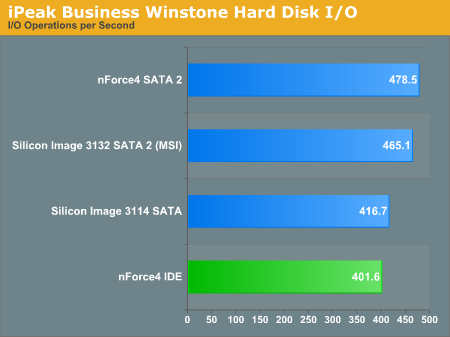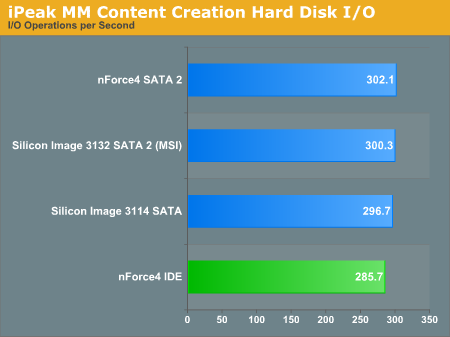nForce4 SLI Roundup: Painful and Rewarding
by Wesley Fink on February 28, 2005 7:00 AM EST- Posted in
- Motherboards
Disk Controller Performance
With so many storage controllers on the nForce4 SLI boards, we needed a means of comparing performance of the wide variety of controllers. The logical choice was Anand's storage benchmark first described in Q2 2004 Desktop Hard Drive Comparison: WD Raptor vs the World. To refresh your memory, the iPeak test was designed to measure "pure" hard disk performance, and in this case, we kept the hard drive as consistent as possible while varying the hard drive controller. The idea is to measure the performance of a hard drive controller with a consistent hard drive. We played back Anand's raw files that recorded I/O operations when running a real world benchmark - in this case, the entire Winstone 2004 suite. Intel's IPEAK utility was then used to play back the trace of all the IO operations that take place during a single run of Business Winstone 2004 and MCC Winstone 2004. To try to isolate performance difference to the controllers that we were testing, we used Seagate 7200.7 model SATA and IDE hard drives for all tests.iPeak gives a mean service time in milliseconds; in other words, the average time that each drive took to fulfill each IO operation. In order to make the data more understandable, we report the scores as an average number of IO operations per second so that higher scores translate into better performance. This number is meaningless as far as hard disk performance is concerned as it is just the number of IO operations completed in a second. However, the scores are useful for comparing "pure" performance of the storage controllers in this case.


The Silicon Image 3114 controller is only a bit slower in MM Content IO, but it is quite a bit slower in Business IO. The 3114 does uniquely feature RAID 3 capabilities and it is featured on 3 of the 4 SLI boards: the Asus, DFI, and Gigabyte.
IDE provided the slowest IO performance in this roundup, demonstrating that SATA controllers are finally starting to show a performance edge - at least in IO operations.
We plan to also include IDE RAID and SATA RAID benchmarks in our future motherboard tests, and comparing RAID performance on various controllers will definitely be a part of future motherboard tests.










108 Comments
View All Comments
eva2000 - Monday, February 28, 2005 - link
whoops no mention of psu was used in system config listing but didn't read till page 20 of the review it mentions OCZ 520W PS psu hehSlaimus - Monday, February 28, 2005 - link
They used a OCZ 520W.neologan - Monday, February 28, 2005 - link
I think the test results for 3dmark2003 single and SLI are the wrong way around?http://www.anandtech.com/mb/showdoc.aspx?i=2358&am...
F4810 - Monday, February 28, 2005 - link
Why did they show no benchmarks with the mobo's overclocked? It doesnt make sense to say these boards are better becuase you can clock the memory higher if the overall CPU clock is roughly the same. The reason they dont show you is that due to the onchip memory controller on the AMD chips, the high memory frequency doesnt make much of a difference at all in real world terms. As long as you can clock the CPU high that is all that really matters. Also they dont take into account cost as some boards cost 50% more that the others.dornick - Monday, February 28, 2005 - link
I was considering jumping on the SLI bandwagon until I had some sense knocked into me.I'd like to see a comparison of the Ultra chipset MBs, including the Chaintech, Epox, etc... since that's where I think the nForce 4 market will go.
eva2000 - Monday, February 28, 2005 - link
missing one vital piece of info, what PSU you used heheSpacecomber - Monday, February 28, 2005 - link
Thanks for doing the indepth analysis of this new chipset and how it is being implemented by some major motherboard manufacturers.There was one detail that I was hoping to see some reference to. I understand, from a friend, who has the MSI SLI motherboard, that the Creative Live sound chip only works if your power supply has a -5 volt connector on it. It looks to me like the OCZ power supply that you used has this, but many of the new power supplies, such as the Enermax v2.0 power supplies, no longer have a -5 volt connection. He was using a Enermax 535 watt Whisper II (SLI ready) when he ran into this issue. This kind of compatability problem slipping through QA seems like another indication that the everyone was in a big hurry to get these motherboards to market, maybe before they were thoroughly tested.
Space
Regs - Monday, February 28, 2005 - link
I liked the subtle hints Wes.In your final words you stated, "If you want the best performance possible then the answer would likely be yes". Then how would this apply for users getting two 6600GTs?
xsilver - Monday, February 28, 2005 - link
great articleminor gripe -- the overclocking "graphs" are useless -- what would be better is the resulting fps of overclocking to show people if its worth it to get that extra xxx fps
arfan - Monday, February 28, 2005 - link
now i am waiting ultra mobo benchmark. What about the price of all this mobo ? i fell disappointed with msi doesn't have PCI 1x. (Sorry my english language is very bad)